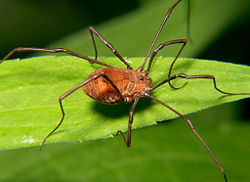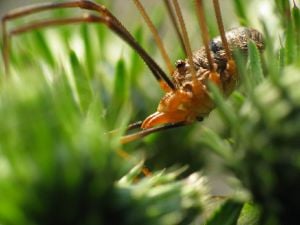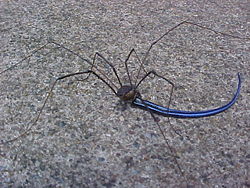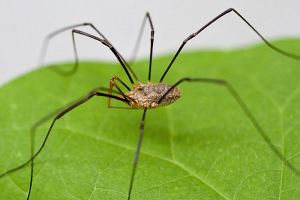Difference between revisions of "Opiliones" - New World Encyclopedia
Rick Swarts (talk | contribs) (added article from Wikipedia and credit/category tags) |
Rick Swarts (talk | contribs) |
||
| Line 29: | Line 29: | ||
Because they are a ubiquitous order, but species are often restricted to small regions due to their low dispersal rate,{{Fact|date=April 2008}} they are good models for [[Biogeography|biogeographic]] studies.{{Dubious|date=April 2008}} | Because they are a ubiquitous order, but species are often restricted to small regions due to their low dispersal rate,{{Fact|date=April 2008}} they are good models for [[Biogeography|biogeographic]] studies.{{Dubious|date=April 2008}} | ||
| − | == | + | ==Overview and description== |
{{main|Harvestman anatomy}} | {{main|Harvestman anatomy}} | ||
[[Image:Harvestmen Close Macro.jpg|thumb|left|A male Phalangium opilio, showing the distinguishable long legs.]] | [[Image:Harvestmen Close Macro.jpg|thumb|left|A male Phalangium opilio, showing the distinguishable long legs.]] | ||
| + | |||
| + | An '''arachnid''' is any member of the [[arthropod]] class '''Arachnida''', a largely terrestrial group that includes [[spider]]s, [[mite]]s, [[tick]]s, [[scorpion]]s, and [[opiliones|harvestmen]] (daddy longlegs). Arachnida is one of the classes of the subphylum Chelicerata (including [[horseshoe crab]]s, sea scorpions, and sea spiders) of the [[phylum]] Arthropoda. Arachnids are characterized by four pairs of segmented walking legs and a body divided into two regions, the cephalothorax and the abdomen. Arachnids are chiefly terrestrial [[invertebrate]]s, comprising some 65,000 to 73,000 named [[species]], including [[spider]]s, [[scorpion]]s, [[opiliones|harvestmen]], [[tick]]s, and [[mite]]s. | ||
| + | |||
These arachnids are known for their exceptionally long walking legs, compared to body size, although there are also short-legged species. The difference between harvestmen and spiders is that in harvestmen the two main body sections (the [[abdomen]] with ten segments and [[cephalothorax]], or ''[[prosoma]]'' and ''[[opisthosoma]]'') are broadly joined, so that they appear to be one [[oval]] structure; they also have no [[venom]] or silk glands. In more advanced species, the first five abdominal segments are often fused into a dorsal shield called the ''[[scutum]]'', which is normally fused with the ''[[carapace]]''. Sometimes this shield is only present in males. The two most posterior abdominal segments can be reduced or separated in the middle on the surface to form two plates lying next to each other. The second pair of legs are longer than the others and work as [[Antenna (biology)|antennae]]. This can be hard to see in short-legged species. | These arachnids are known for their exceptionally long walking legs, compared to body size, although there are also short-legged species. The difference between harvestmen and spiders is that in harvestmen the two main body sections (the [[abdomen]] with ten segments and [[cephalothorax]], or ''[[prosoma]]'' and ''[[opisthosoma]]'') are broadly joined, so that they appear to be one [[oval]] structure; they also have no [[venom]] or silk glands. In more advanced species, the first five abdominal segments are often fused into a dorsal shield called the ''[[scutum]]'', which is normally fused with the ''[[carapace]]''. Sometimes this shield is only present in males. The two most posterior abdominal segments can be reduced or separated in the middle on the surface to form two plates lying next to each other. The second pair of legs are longer than the others and work as [[Antenna (biology)|antennae]]. This can be hard to see in short-legged species. | ||
Revision as of 15:08, 7 December 2008
| Opiliones
| ||||||||||
|---|---|---|---|---|---|---|---|---|---|---|
 Hadrobunus grandis
| ||||||||||
| Scientific classification | ||||||||||
| ||||||||||
| Diversity | ||||||||||
| 4 suborders, > 6,400 species | ||||||||||
|
Cyphophthalmi |
Harvestmen are eight-legged invertebrate animals belonging to the order Opiliones (formerly Phalangida) in the class Arachnida, in the subphylum Chelicerata of the phylum Arthropoda. As of 2006, over 6,400 species of harvestmen have been discovered worldwide, although the real number of extant species may exceed 10,000.[1] The order Opiliones can be divided in four suborders: Cyphophthalmi (Simon, 1879), Eupnoi (Hansen & Sørensen, 1904), Dyspnoi (Hansen & Sørensen, 1904) and Laniatores (Thorell, 1876). Well-preserved fossils have been found in the 400-million year old Rhynie cherts of Scotland, which look surprisingly modern, indicating that the basic structure of the harvestmen has not changed much since then. Phylogenetic position is disputed: their closest relatives may be the mites (Acari) or the Novogenuata (the Scorpiones, Pseudoscorpiones and Solifugae).[citation needed]
Although they belong to the class of arachnids, harvestmen are not spiders, which are of the order Araneae rather than the order Opiliones.
In some places, harvestmen are known by the name "daddy longlegs" or "granddaddy longlegs", but this name is also used for two other unrelated arthropods: the crane fly (Tipulidae) and the cellar spider (Pholcidae).[citation needed]
Because they are a ubiquitous order, but species are often restricted to small regions due to their low dispersal rate,[citation needed] they are good models for biogeographic studies.[dubious — see talk page]
Overview and description
An arachnid is any member of the arthropod class Arachnida, a largely terrestrial group that includes spiders, mites, ticks, scorpions, and harvestmen (daddy longlegs). Arachnida is one of the classes of the subphylum Chelicerata (including horseshoe crabs, sea scorpions, and sea spiders) of the phylum Arthropoda. Arachnids are characterized by four pairs of segmented walking legs and a body divided into two regions, the cephalothorax and the abdomen. Arachnids are chiefly terrestrial invertebrates, comprising some 65,000 to 73,000 named species, including spiders, scorpions, harvestmen, ticks, and mites.
These arachnids are known for their exceptionally long walking legs, compared to body size, although there are also short-legged species. The difference between harvestmen and spiders is that in harvestmen the two main body sections (the abdomen with ten segments and cephalothorax, or prosoma and opisthosoma) are broadly joined, so that they appear to be one oval structure; they also have no venom or silk glands. In more advanced species, the first five abdominal segments are often fused into a dorsal shield called the scutum, which is normally fused with the carapace. Sometimes this shield is only present in males. The two most posterior abdominal segments can be reduced or separated in the middle on the surface to form two plates lying next to each other. The second pair of legs are longer than the others and work as antennae. This can be hard to see in short-legged species.
The feeding apparatus (stomotheca) differs from other arachnids in that ingestion is not restricted to liquid, but chunks of food can be taken in. The stomotheca is formed by extensions from the pedipalps and the first pair of legs.
They have a single pair of eyes in the middle of their heads, oriented sideways. However, there are eyeless species (for example the Brazilian Caecobunus termitarum (Grassatores) from termite nests, Giupponia chagasi (Gonyleptidae) from caves, and all species of Guasiniidae)[2].

Harvestmen have a pair of prosomatic defensive scent glands (ozopores) that secrete a peculiar smelling fluid when disturbed, confirmed in some species to contain noxious quinones. Harvestmen do not have silk glands and do not possess venom glands, posing absolutely no danger to humans (see below). They do not have book lungs, and breathe through tracheae only. Between the base of the fourth pair of legs and the abdomen a pair of spiracles are located, one opening on each side. In more active species, spiracles are also found upon the tibia of the legs. They have a gonopore on the ventral cephalothorax, and the copulation is direct as the male has a penis (while the female has an ovipositor). All species lay eggs.
The legs continue to twitch after they are detached. This is because there are 'pacemakers' located in the ends of the first long segment (femur) of their legs. These pacemakers send signals via the nerves to the muscles to extend the leg and then the leg relaxes between signals. While some harvestman's legs will twitch for a minute, other kinds have been recorded to twitch for up to an hour. The twitching has been hypothesized as a means to keep the attention of a predator while the harvestman escapes.[3]
Typical body length does not exceed 7 mm (about 5/16 inch), with some species smaller than one mm, although the largest species Trogulus torosus (Trogulidae) can reach a length of 22 mm[1]. However, leg span is much larger and can exceed 160 mm (over 6 inch). Most species live for a year.
Behavior

Many species are omnivorous, eating primarily small insects and all kinds of plant material and fungi; some are scavengers, feeding upon dead organisms, bird dung and other fecal material. This broad range is quite unusual in arachnids, which are usually pure predators. Most hunting harvestmen ambush their prey, although active hunting is also found. Because their eyes cannot form images, they use their second pair of legs as antennae to explore their environment. Also unlike most other arachnids, harvestmen do not have a sucking stomach and a filtering mechanism, but ingest small particles of their food, thus making them vulnerable to internal parasites, such as gregarines.[4]
Although parthenogenetic species do occur, most harvestmen reproduce sexually. Mating involves direct copulation, rather than the deposition of a spermatophore. The males of some species offer a secretion from their chelicerae to the female before copulation. Sometimes the male guards the female after copulation, and in many species the males defend territories. The females lay eggs shortly after mating, or up to months later. Some species build nests for this purpose. A unique feature of harvestmen is that in some species the male is solely responsible for guarding the eggs resulting from multiple partners, often against egg-eating females, and subjecting the eggs to regular cleaning. The eggs can hatch anytime after the first 20 days, up to almost half a year after being laid. Harvestmen need from four to eight nymphal stages to reach maturity, with six the most common.[5]
They are mostly nocturnal and colored in hues of brown, although there are a number of diurnal species which have vivid patterns in yellow, green and black with varied reddish and blackish mottling and reticulation.
To deal with predators such as birds, mammals, amphibians, and spiders, some species glue debris onto their body, and many play dead when disturbed. Many species can detach their legs, which keep on moving to confuse predators, especially long-legged species vibrate their body ("bobbing"), probably also to confuse. This is similar to the behavior of the similar looking but unrelated daddy longlegs spider, which vibrates wildly in its web when touched. Scent glands emit substances that can deter larger predators, but are also effective against ants.[6]
Many species of harvestmen easily tolerate members of their own species, with aggregations of many individuals often found at protected sites near water. These aggregations can count up to 200 animals in the Laniatores, but more than 70,000 in certain Eupnoi. This behavior is likely a strategy against climatic odds, but also against predators, combining the effect of scent secretions, and reducing the probability of each individual of being eaten.[7]
Endangered status
Some troglobitic (cave dwelling) Opiliones are considered endangered if their home caves are in or near cities where pollution and development of the land can alter the cave habitat. Others species are threatened by the invasion of non-native fire ants.
All troglobitic species (of all animal taxa) are considered to be at least threatened in Brazil. There are four species of Opiliones in the Brazilian National List for endangered species, all of them cave-dwelling species. Giupponia chagasi Pérez & Kury, 2002, Iandumoema uai Pinto-da-Rocha, 1996, Pachylospeleus strinatii Šilhavý, 1974 and Spaeleoleptes spaeleus H. Soares, 1966.
Several Opiliones in Argentina appear to be vulnerable, if not endangered. These include Pachyloidellus fulvigranulatus (Mello-Leitão, 1930), which is found only on top of Cerro Uritorco, the highest peak in the Sierras Chicas chain (provincia de Cordoba) and Pachyloides borellii (Roewer, 1925) is in rainforest patches in North West Argentina which are in an area being dramatically destroyed by humans. The cave living Picunchenops spelaeus Maury, 1988 is apparently endangered through human action. So far no harvestman has been included in any kind of a Red List in Argentina and therefore they receive no protection.
Maiorerus randoi Rambla, 1993 has only been found in one cave in the Canary Islands. It is included in the Catálogo Nacional de especies amenazadas (National catalog of threatened species) from the Spanish government.
Texella reddelli Goodnight & Goodnight, 1967 and Texella reyesi Ubick & Briggs, 1992 are listed as endangered species in the USA. Both are from caves in central Texas. Texella cokendolpheri Ubick & Briggs, 1992 from a cave in central Texas and Calicina minor (Briggs & Hom, 1966), Microcina edgewoodensis Briggs & Ubick, 1989, Microcina homi Briggs & Ubick, 1989, Microcina jungi Briggs & Ubick, 1989, Microcina leei Briggs & Ubick 1989, Microcina lumi Briggs & Ubick, 1989, and Microcina tiburona (Briggs & Hom, 1966) from around springs and other restricted habitats of central California are being considered for listing as endangered species, but as yet receive no protection.
Misconception
An urban legend claims that the harvestman is the most venomous animal in the world, but possesses fangs too short or a mouth too round and small to bite a human and therefore is not dangerous. (The same myth applies to the cellar spider, which is also called a daddy longlegs.)[8] This is untrue on several counts. None of the known species have venom glands or fangs, instead having chelicerae.[9] The size of its mouth varies by species, but even those with relatively large jaws hardly ever bite humans or other large creatures, even in self-defense. The few known cases of actual bites did not involve envenomation, and had no lasting effect.[10]
Research
Harvestmen are a scientifically much neglected group. Description of new taxa has always been dependent on the activity of a few dedicated taxonomists. Carl Friedrich Roewer described about a third (2,260) of today's known species from the 1910s to the 1950s, and published the landmark systematic work Die Weberknechte der Erde (Harvestmen of the World) in 1923, with descriptions of all species known to that time. Other important taxonomists in this field include Eugène Simon, Tord Tamerlan Teodor Thorell, William Sørensen and Zac Jewell around the turn of the 20th century, and later Cândido Firmino de Mello-Leitão and Reginald Frederick Lawrence. Since 1980, study of the biology and ecology of harvestmen has intensified, especially in South America.[1]
Phylogeny
Harvestmen are very old arachnids. Fossils from the Devonian, 400 million years ago, already show characteristics like tracheae and sexual organs, proving that the group has lived on land since that time. They are probably closely related to the scorpions, pseudoscorpions and solifuges; these four orders form the clade Domopod. The Opiliones have remained almost unchanged morphologically over a long period.[11]
Systematics
- Stylocellidae Hansen & Sørensen 1904
- Ogoveoidea Shear 1980
- Ogoveidae Shear 1980
- Neogoveidae Shear 1980
- Temperophthalmi Shear 1980
- Sironoidea Simon 1879
- Pettalidae Shear 1980
- Sironidae Simon 1879
- Troglosironidae Shear 1993
- Eupnoi Hansen & Sørensen 1904 (c. 1,800 species)
- Caddoidea Banks 1892
- Caddidae Banks 1892
- Phalangioidea Latreille 1802
- Monoscutidae Forster 1948
- Neopilionidae Lawrence 1931
- Sclerosomatidae Simon 1879
- Phalangiidae Latreille 1802
- Dyspnoi Hansen & Sørensen 1904 (c. 320 species)
- Ischyropsalidoidea Simon 1879
- Ceratolasmatidae Shear 1986
- Ischyropsalididae Simon 1879
- Sabaconidae Dresco 1970
- Nemastomatoidea Simon, 1872
- Dicranolasmatidae Simon 1879
- Nemastomatidae Simon 1872
- † Nemastomoididae Petrunkevitch 1955 (fossil: Carboniferous)
- Nipponopsalididae Martens 1976
- Troguloidea Sundevall 1833
- † Eotrogulidae (fossil: Carboniferous)
- Trogulidae Sundevall 1833
- Laniatores Thorell, 1876 (c. 4,000 species)
- Insidiatores Loman, 1900
- Travunioidea Absolon & Kratochvil 1932
- Cladonychiidae Hadzi, 1935
- Pentanychidae Briggs 1971
- Travuniidae Absolon & Kratochvil 1932
- Triaenonychoidea Sørensen, 1886
- Triaenonychidae Sørensen, 1886
- Synthetonychiidae Forster 1954
- Grassatores Kury, 2002
- Samooidea Sørensen, 1886
- Biantidae Thorell, 1889
- Escadabiidae Kury & Pérez, 2003
- Kimulidae Pérez González, Kury & Alonso-Zarazaga, 2007 (= Minuidae Sørensen, 1932)
- Podoctidae Roewer, 1912
- Samoidae Sørensen, 1886
- Stygnommatidae Roewer, 1923
- Epedanoidea Sørensen, 1886
- Epedanidae Sørensen, 1886
- Gonyleptoidea Sundevall, 1833
- Agoristenidae Šilhavý, 1973
- Assamiidae Sørensen, 1884
- Cosmetidae Koch, 1839
- Cranaidae Roewer, 1913
- Gonyleptidae Sundevall, 1833
- Manaosbiidae Roewer, 1943
- Stygnidae Simon, 1879
- Stygnopsidae Sørensen, 1932
- Phalangodoidea Simon, 1879
- Oncopodidae Thorell, 1876 — possibly misplaced
- Phalangodidae Simon, 1879
- Zalmoxoidea Sørensen, 1886
- Fissiphalliidae Martens, 1988
- Guasiniidae Gonzalez-Sponga, 1997
- Icaleptidae Kury & Pérez, 2002
- Zalmoxidae Sørensen, 1886
The family Stygophalangiidae (1 species, Stygophalangium karamani) from underground waters in Macedonia is sometimes misplaced in the Phalangioidea. It is not a harvestman.
Footnotes
- ↑ 1.0 1.1 1.2 Pinto-da-Rocha et al. 2007: 5
- ↑ Pinto-da-Rocha & Kury 2003: 397
- ↑ Pinto-da-Rocha et al. 2007
- ↑ Pinto-da-Rocha et al. 2007:9
- ↑ Pinto-da-Rocha et al. 2007: 8, 11
- ↑ Pinto-da-Rocha et al. 2007: 9-10
- ↑ Pinto-da-Rocha et al. 2007: 11
- ↑ The Spider Myths Site: Daddy-Longlegs
- ↑ The Arachnology Home Page: Answers to commons questions about harvestmen
- ↑ Snopes: Daddy Longlegs
- ↑ Pinto-da-Rocha et al. 2007: 4
ReferencesISBN links support NWE through referral fees
- Joel Hallan's Biology Catalog (2005)
- Pinto-da-Rocha, R., Machado, G. & Giribet, G. (eds.) (2007): Harvestmen - The Biology of Opiliones. Harvard University Press ISBN 0-674-02343-9
- Pinto-da-Rocha, R. & Kury, A.B. (2003): Third species of Guasiniidae (Opiliones, Laniatores) with comments on familial relationships. Journal of Arachnology 31(3): 394-399. PDF
Further reading
- Shultz, Jeffrey W. (1998): Phylogeny of Opiliones (Arachnida): An Assessment of the "Cyphopalpatores" Concept. Journal of Arachnology 26(3): 257-272. PDF
External links
- Harvestman: Order Opiliones Diagnostic photographs and information on North American harvestmen
- Harvestman: Order Opiliones Diagnostic photographs and information on European harvestmen
- University of Aberdeen: The Rhynie Chert Harvestmen (fossils)
- National Museum page Classification of Opiliones A synoptic taxonomic arrangement of the order Opiliones, down to family-group level, including some photos of the families
Credits
New World Encyclopedia writers and editors rewrote and completed the Wikipedia article in accordance with New World Encyclopedia standards. This article abides by terms of the Creative Commons CC-by-sa 3.0 License (CC-by-sa), which may be used and disseminated with proper attribution. Credit is due under the terms of this license that can reference both the New World Encyclopedia contributors and the selfless volunteer contributors of the Wikimedia Foundation. To cite this article click here for a list of acceptable citing formats.The history of earlier contributions by wikipedians is accessible to researchers here:
The history of this article since it was imported to New World Encyclopedia:
Note: Some restrictions may apply to use of individual images which are separately licensed.


